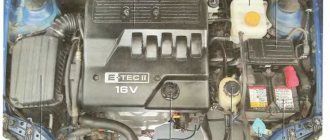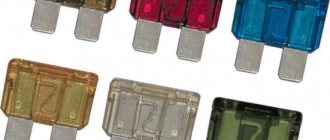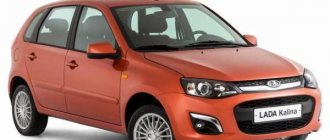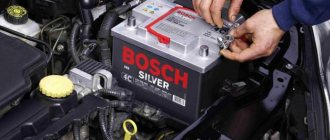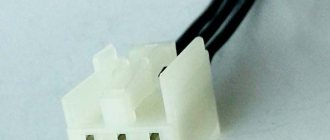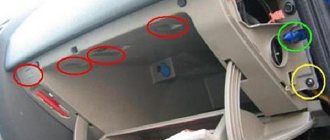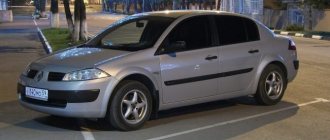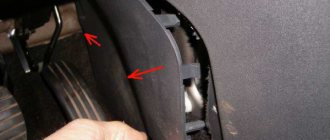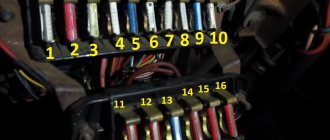Fuses and relays in the interior of Renault Megane 3
The main mounting block in the car interior is located on the driver's side at the bottom of the control panel.
Fuse box diagram in the interior of Renault Megane 3
Description
| F1 | reserve |
| F2 | reserve |
| F3 | 10A cigarette lighter fuse Renault Megane 3 |
| F4 | 10A rear socket |
| F5 | 10A socket in luggage compartment |
| F6 | 10A audio system |
| F7 | 5A electric heated exterior mirrors |
| F8 | 10A windshield washer, door open alarm |
| F9 | 30A automatic parking brake |
| F10 | 10A instrument panel |
| F11 | 25A electric seat, steering column switches |
| F12 | 20A electric heated passenger seat |
| F13 | reserve |
| F14 | 25A electric window lifter for the front passenger door |
| F15 | 5A brake light switch, brake pedal position sensor, ABS/ESP control unit |
| F16 | 25A power window right rear door |
| F17 | 25A electric window lifter of the left rear door |
| F18 | 10A glove compartment lamp, left luggage compartment lamp, door lamps, sun visor mirror lamps, rain sensor |
| F19 | 10A clock, outside temperature indicator, seat belt warning light, audio system connector |
| F20 | 5A climate control unit |
| F21 | 3A mirror illumination lamps in sun visors |
| F22 | 3A interior lamps, rain and light sensor |
| F23 | 20A trailer connector |
| F24 | 15A UCH |
| F25 | 3A interior rear view mirror |
| F26 | 10A navigation system, CD changer, audio system |
| F27 | 20A audio system, parking brake control unit |
| F28 | reserve |
| F29 | reserve |
| F30 | 15A UCH, direction indicators |
| F31 | 10A UCH |
| F32 | 30A power window driver's door |
| F33 | 25A UCH, central locking |
| F34 | 30A Passenger's door multiplex network control unit |
| F35 | 15A clock, outside temperature indicator, telephone display |
| F36 | 15A diagnostic connector, horn relay, alarm control unit, siren |
| F37 | 10A brake signals, electrical control unit |
| F38 | 30A automatic parking brake |
| F39 | 30A convertible roof ECU |
| F40 | 40A electric air conditioning fan |
| F41 | 25A electric sunroof |
| F42 | 40A heated rear window |
- RA 70A - power relay (+battery) with shutdown delay (without turning off power at startup)
- RB 70A - power relay (+battery) with shutdown delay (with power off at startup)
- RC 40C - rear window heating relay
- RD 20A - horn relay
Renault Megane 3 Owner's Manual
The official manual for the operation, design and maintenance of Renault Megane 3 cars is issued to each car buyer, along with basic documents.
The manual describes the design of the car, information on the correct operation of both the car as a whole and its components.
This vehicle operation and maintenance manual contains information that will allow you to: – become familiar with the vehicle, operate it correctly and make the most of its capabilities. – maintain its optimal performance by simply but strictly following the maintenance advice.
– quickly eliminate minor faults that do not require specialist intervention.
The short time you spend reading this manual will be more than repaid by the information you acquire, as well as knowledge of the functionality and technical innovations that are used in the design of your vehicle.
Chapter 1. Getting to know the car RENAULT maps: general information, use, full lock mode Opening and closing doors Automatic locking of opening body elements when driving Head restraints / Seats Seats Seat belts Passive safety system: a.
driver and front passenger b. rear passengers c. Side Restraints Child Restraint System: General Information a. choice of child seat mounting b. installing a child seat c.
turning off/on the front passenger airbag Steering wheel Power steering Driver's seat Instrumentation a. warning lights b. on-board computer c.
menu for individual vehicle settings Indications of time and outside air temperature Rear-view mirrors Sound and light alarms External lighting and alarm devices Adjustment of headlights Windshield wipers, windshield washers Fuel tank (fueling)
Identification marking
Chapter 2.
Driving a car (recommendations for economical and environmentally safe operation of a car) Running in a car Starting, stopping the engine Stop and Start function Features of cars with a gasoline engine Features of cars with a diesel engine Gearbox lever Parking brake Electric parking brake Recommendations: reducing exhaust emissions and fuel economy Security environmental protection Tire pressure monitoring system Correction and driving assistance systems Lane crossing signal Speed limit system Speed maintenance system Parking assistance system Rear view camera
Automatic transmission
Chapter 3: Comfort Ventilation grilles Manual air conditioning Automatic air conditioning system Air conditioning system: information and operating tips Power windows, power sunroof Mechanical windows Interior lighting Sun visor Storage compartments, interior equipment Accessories power socket Ashtray. Cigarette lighter Rear bench seat Luggage compartment Rear storage shelf Luggage compartment shelf: station wagons Glove boxes, luggage compartment equipment Cargo transportation: f. in the trunk b. towing device luggage compartment net roof rack crossbars
Multimedia equipment
Chapter 4. Car care Hood Engine oil level: a. general information b. adding oil, refueling Changing engine oil Levels of operating fluids a. coolant b. brake fluid c. Windshield/Headlight Washer Reservoir Filters Tire Pressure Battery Car Body Care
Car interior care
Chapter 5. Practical advice Tire puncture Spare wheel Tire inflation kit Tool kit (wheel wrench/jack, etc.)
) Decorative wheel cover Wheel replacement Tires (safety conditions when using tires, wheels, winter operation) Headlights (replacement of lamps) Rear Interior lighting (replacement of lamps) Fuses Battery RENAULT card: battery Place for installing a car radio Additional equipment Windshield wiper blades Towing when malfunctions
Operational disruptions
Chapter 6. Specifications Vehicle Identification Plates Engine Identification Plates Vehicle Dimensions Engine Specifications Weight Specifications Trailer Tow Weight Spare Parts and Repairs Maintenance Support Documents
Checking the anti-corrosion coating
Fuses and relays under the hood of Renault Megane 3
The main unit in the engine compartment is the protection and switching unit, located on the left side near the pillar and fender of the car.
Diagram of the fuse and relay box under the hood of Renault Megane 3
Description
- 10A - Side light (right headlight, right rear light, headlights), license plate lights, cigarette lighter illumination, power window switch illumination, audio system, navigation system control unit, multimedia system keyboards
- 10A - Side light (left block headlight, left rear light), left light on the tailgate
- 15A - Headlight washer pump
- 20A - Fog lights
- 10A - High beam (left headlight)
- 10A - High beam (right headlight)
- 15A - Diagnostic connector, rear window heating relay, automatic transmission mode selector, electric headlight adjustment, gas-discharge lamp control unit, auxiliary heater control unit, speed limiter, automatic parking brake, automatic parking system control unit, interior dimming mirror
- 30A - ABS, ESP control unit
- 30A - Front wiper
- 10A - Airbag control unit
- 20A - Not used
- 7.5A - transmission ECU
- 25A - Engine control system
- 15A - Oxygen concentration sensors - heating
- 20A - transmission ECU
- 5A - Brake signals, electrical control unit, electric power steering
- 10A - Automatic transmission operating mode sensor, electric headlight leveler, reverse light relay
- 15A - Electrical equipment control unit
- 30A - Starter
- - Not used
- 20A - Fuel module, ignition coils, LPG power system ECU
- 10A - Electromagnetic clutch of the air conditioning compressor
- 5A - injection computer
- 20A - Low beam (left headlight), electric corrector
- 20A - Low beam (right headlight), electric corrector
- - Not used
Important! Fuses 24, 25 and 26 on the protection unit may not be removed.
DIY Renault Megane repair
The car portal etlib.ru invites visitors to familiarize themselves with instructions that will allow them to carry out repairs for Renault Megane themselves.
Presented in the form of videos and photo reports, they will become a reliable support and will allow you to master repair procedures in a minimum amount of time.
Only here you will find advice from experienced owners that will complement the detailed repair manual for Renault Megane and protect the driver from possible mistakes.
Those who are interested in the repair and operation of the Megane should start studying the section with the most common procedures used by the owners of this car model. These include replacing the Renault Megane generator, replacing the Renault Megane fuel filter and, in Renault Megane, replacing the timing belt.
For the second generation, it is also worth studying how to replace Renault Megane 2 lamps and replace the Renault Megane 2 thermostat. Information regarding the chassis will be no less important.
For Renault Megane drivers, replacing silent blocks may come in handy at the most unexpected time, when there are no authorized specialists nearby.
The site is updated daily with useful content . However, there are cases where guidance on a specific procedure has not yet been created.
In order to find out the details of the algorithm, a list of repair tools and other key nuances, each visitor can contact the motorist community. It's easy to do. Just click on the appropriate portal menu button and then formulate the question correctly .
The answer will not be long in coming, thanks to the high traffic on the site and the many experienced drivers trying to help others at every opportunity.
Development of the Renault Megane model range
First generation. The car was first demonstrated in 1995. At the same time, it began to appear in stores.
The Renault Megane model received 5 body styles: sedan, hatchback, station wagon, coupe and convertible. The model was equipped with a 1.6 liter gasoline engine.
4 years later, in 1999, the Renault Megane I model received a visual update and acquired a large number of engines to choose from, including 16-valve ones .
Second generation. Appearing in 2002, the representative of the second generation attracted attention with a new extravagant design with sharp lines.
As before, it offered a wide range of options, but for this one there were only 3 body types .
A distinctive feature of the series is the use of diesel engine models, as well as improvements in safety.
Third generation. In 2008, a new model appeared under the symbol “III”. In her appearance, the previous forms disappeared, the body became smoother and more pleasant to look at. In 2012 and 2014, the manufacturer carried out two restylings . Both touched on the exterior of the car.
Fourth generation. In the fall of 2015, fans of the brand saw the model of the next series of Renault Megane IV. The aggressive, stylish design made the car look more sporty. Sales will begin in 2016.
More details
Block No. 2 in the engine compartment of Renault Megane 3
The mounting block is located under the protection and switching block.
Diagram of the fuse and relay box under the hood of Renault Megane 3
Description
- A - Not used
- B - Fuel heater relay
- C - Reverse light relay
- D - Not used
- F1 - 80A submersible heater control unit
- F2 - 70A preheater
- F3 - Not used
- F4 - 80A submersible heater control unit
- F5 - 60A / 40A electric fan relay
- F6 - 20A Fuel heater
- F7 - Not used
- F8 - 30A electric fan relay
- F9 - Not used
Blocks near the battery
Near the battery there are 2 additional blocks.
Diagram of the battery disconnect unit (in Fig. 1)
Description
- F1 - 190A Starter
- F2 - 50A interior fuse and relay box
- F3 - 80A fuse and relay box (control and switching unit) in the engine compartment 1, fuse and relay box in the passenger compartment
- F4 - 300A/190A Engine Compartment 2 Fuse/Relay Box/Generator
- F5 - 80A electric power steering
- F6 - 35A electronic engine control unit (ECU) / fuse and relay box (control and switching unit) in the engine compartment 1
- F7 - 5A fuse and relay block (control and switching unit) in the engine compartment 1
Diagram of a high power fuse block (in Fig. 2)
Description
- 70A - additional interior heater
- 80A - fuse and relay box in the passenger compartment
- 80A - fuse and relay box in the passenger compartment
- 80A - fuse and relay box (control and switching unit) in the engine compartment 1, fuse and relay box in the passenger compartment
- 30A - additional heater
- 50A - ABS ECU with ESP
Important! An electric fan relay for the engine cooling system may be located next to the electric fan.
